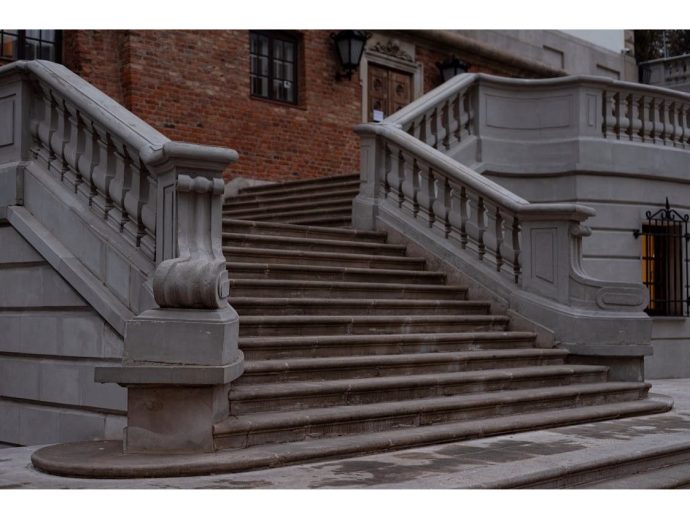Categories more
- Adventures (16)
- Arts / Collectables (14)
- Automotive (36)
- Aviation (10)
- Bath, Body, & Health (73)
- Children (6)
- Cigars / Spirits (30)
- Cuisine (16)
- Design/Architecture (17)
- Electronics (12)
- Entertainment (4)
- Event Planning (3)
- Fashion (42)
- Finance (8)
- Gifts / Misc (6)
- Home Decor (44)
- Jewelry (39)
- Pets (3)
- Philanthropy (1)
- Real Estate (12)
- Services (21)
- Sports / Golf (14)
- Vacation / Travel (60)
- Watches / Pens (14)
- Wines / Vines (24)
- Yachting / Boating (15)
Timeless Beauty: The Rise of Custom Stone Handrails in Modern Architecture
Published
01/12/2025Architecture is an ever-evolving art form, constantly shaped by the interplay between tradition and innovation. One element that perfectly embodies this dynamic is modern design's resurgence of custom stone handrails. Blending durability, elegance, and functionality, these handrails are becoming increasingly popular as architects and homeowners seek timeless design solutions that stand out in contemporary spaces.
The Historical Significance of Stone in Architecture
Stone has been a fundamental building material throughout human history. From ancient temples to medieval castles, stone was used to create structures that were not only functional but also aesthetically magnificent. Stone handrails, carved from stone, were a staple in grand staircases, symbolizing wealth and craftsmanship.
Modern architecture revives this tradition. However, today's stone handrails are far from the rigid, imposing designs of the past. Instead, they offer a sleek, customized look that complements contemporary aesthetics. This shift reflects a renewed appreciation for natural materials and the desire to merge traditional craftsmanship with modern innovation.
Why Custom Stone Handrails Are Gaining Popularity
One of the main reasons for the growing demand for custom stone handrails is their versatility. Unlike mass-produced metal or wooden handrails, custom stone designs can be tailored to fit any architectural style, from minimalist modern homes to opulent mansions. This flexibility makes them attractive for designers looking to create unique, statement features.
Moreover, stone is inherently durable and long-lasting. While wood can rot and metal can corrode, stone withstands the test of time with minimal maintenance. This durability makes it an eco-friendly option, reducing the need for frequent replacements and repairs. Homeowners and architects alike are drawn to materials with longevity and aesthetic appeal, making stone handrails a top contender.
The Craftsmanship Behind Custom Stone Handrails
Creating a custom stone handrail is an art form in itself. Skilled artisans work meticulously to shape the stone into precise designs that complement the overall architecture of a space. This craftsmanship ensures that each handrail is a one-of-a-kind piece, reflecting the unique personality of the building it adorns.
Modern tools and techniques have made working with stone easier, allowing for more intricate designs and detailed carvings. The possibilities are endless, whether it's a classic spiral staircase or a sleek linear handrail. This level of customization is another reason why custom stone handrails are becoming a preferred choice in residential and commercial architecture.
Stone Handrails and Modern Design Trends
Today's architectural trends emphasize sustainability and authenticity. Homeowners are increasingly prioritizing natural materials that look beautiful and contribute to a healthier living environment. Stone fits perfectly into this narrative, offering a natural, non-toxic option that enhances indoor air quality and reduces reliance on synthetic materials.
In terms of design, stone handrails can create striking contrasts in modern interiors. Imagine a contemporary, minimalist home with clean lines and neutral colors. With its natural texture and earthy tones, a custom stone handrail adds warmth and character to an otherwise sleek space. This contrast between modern simplicity and natural elegance is a hallmark of current design trends.
The Role of Custom Stone Handrails in Outdoor Spaces
Custom stone handrails aren't limited to indoor spaces. They are also increasingly used in landscape architecture, enhancing the beauty of outdoor areas. From garden pathways to poolside staircases, stone handrails add a touch of luxury and refinement to any outdoor setting.
Stone is particularly well-suited for outdoor use due to its weather-resistant properties. Unlike wood, which can warp and deteriorate when exposed to the elements, stone remains resilient in various climates. This makes it ideal for outdoor handrails that withstand sun, rain, and temperature fluctuations.
Maintenance and Longevity
One of the most appealing aspects of custom stone handrails is their low maintenance requirements. Unlike metal handrails, which require regular painting to prevent rust, or wooden handrails, which need sealing to avoid rot, stone handrails require minimal upkeep. A simple cleaning routine is usually enough to keep them looking their best for decades.
This longevity translates into cost-effectiveness over time. While the initial investment in custom stone handrails may be higher than other materials, the reduced need for repairs and replacements makes them a smart, long-term choice for property owners.
The rise of custom stone handrails in modern architecture is a testament to the enduring appeal of natural materials and bespoke craftsmanship. By blending tradition with contemporary design, these handrails offer a timeless solution that enhances any space's functionality and aesthetic. As architects and designers continue to explore the possibilities of stone, custom handrails will remain a symbol of timeless beauty and architectural innovation. In a world that often favors the fast and disposable, the legacy of custom stone handrails reminds us of the value of quality, craftsmanship, and enduring design. For those seeking the highest quality custom-cut stone solutions, visit Deleese Stone. Their expertise in stone fabrication ensures that your project will stand the test of time with unmatched elegance and precision.















